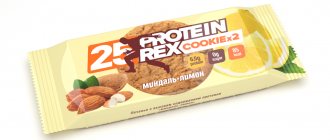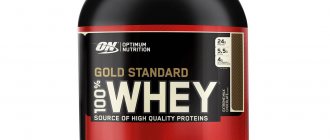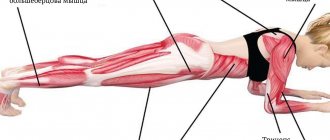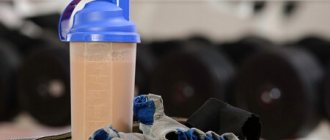Today there is a real boom in demand for everything healthy and correct. Manufacturers have jumped on the bandwagon and are stocking stores with a variety of protein-infused products, including a variety of bars that are begging to be used as a healthy snack. We took all the bars with the word protein that we found from store shelves and studied their taste and composition. We share the results with you.
Protein Bar Bionova No. 9 Chocolate & Nuts with prebiotic
So, first we open a bar under the Bionova brand. It is the only one in the line labeled “protein”; the rest of the nut and fruit bars from this manufacturer simply do not contain sugar and are made mainly from various nuts and dates. This one is no exception.
We read the ingredients: dried dates, dried orange zest, natural highly purified pea protein Pisane® (Belgium), dietary fiber from chicory - inulin, cashews, raisins, cocoa powder, Belgian dark chocolate, chia seeds, cinnamon, ground cloves.
As you can see, pea protein is used as an ingredient that justifies the “protein” label. The bar itself does not contain sugar, it uses only dried fruits, nuts, spices and Belgian chocolate. The composition is very good, the consistency of the bar is dense. Although there is a bitter aftertaste characteristic of protein powder.
KBZHU
The bar contains 6 grams of protein per 35 grams of total weight. Fats – 2.5 grams, carbohydrates – 12 grams, dietary fiber – 5.5 grams.
CHAMP bar! Protein bar “Chocolate cherry” with L-carnitine
Next we will look at a bar from. Bright packaging, embossed press on the label and the inscription L-Carnitine. Lots of marketing gimmicks, but if you look at the ingredients and take a closer look at the product, it turns out that it is more of a confectionery product than a sports nutrition. As you know, the substances in the composition are indicated, depending on their percentage, in descending order. That is, if sugar comes first, then the product contains the most sugar, and then in descending order. And here in first place is molasses, which in its properties and characteristics differs from sugar, and is used by confectioners because it is cheaper than sugar. In second place is soy protein (one of the cheapest), in third and fourth place are milk powder and sugar, and then icing, which also contains sugar. As we understand, there is a lot of sugar in the product. Inexpensive (relative to other protein products) soy protein was used as protein. The composition also contains maltodextrin (read our post about it). In general, the composition does not shine, to put it mildly. It's not bad for a regular chocolate bar. And at the end of the composition, after flavorings, you will find L-carnitine, which does not have any particular functions.
A funny observation: on the manufacturer’s website you will not find the full composition, but only the “ingredients” and beneficially extracted substances. Due to the combination of all the tricks, it seems that the manufacturer is trying to hide the real picture.
Ingredients on the manufacturer's website. Compare with the real composition.
KBJU (per 100 grams of product / in a bar):
- proteins – 16.7 / 7.5;
- fats – 10 / 4.5;
- carbohydrates – 51.1 / 23.
Pros: delicious chocolate.
Cons: Marketing gimmicks, cheap protein, lots of sugar, not a healthy food.
Vote for the bar
Compound
As with many sports nutrition products, the basis of the bars is easily digestible protein. In addition to it, flavoring additives are included: chocolate, vanilla, etc. But with such a standard set of components, the protein composition of such bars is strikingly different from pure protein preparations.
Most bars are based on gelatin and collagen, which are necessary not to provide the body with proteins, but to maintain the shape of the bar itself.
In addition to simple flavoring additives, very useful ones can be added to protein bars without sugar and carbohydrates: L-carnitine, creatine, guarana and various vitamin complexes. Let's consider what effect they have on the human body.
Creatine is one of the most popular supplements among athletes. It does not promote mass gain, but provides energy for their construction.
With a well-organized diet of a protein bar with the addition of creatine, the body’s daily need for this substance is reduced to zero. If you are not a professional athlete, you will also benefit from getting keratin into your body, since this substance not only helps you recover after heavy physical activity, but also burns excess fat reserves, relieves inflammation in muscle tissue, and removes “bad” cholesterol.
L-carnitine is also a fat burner that stimulates tissue repair capacity. Under the influence of this substance, fat metabolism processes are activated in humans.
In addition, this substance helps build muscles, strengthens the immune system, removes dangerous cholesterol from the body, improves brain activity, and stabilizes blood pressure.
Guarana is a plant product that grows in South America. The extract reduces fatigue, increases energy and performance.
The ratio of proteins and guarana extract allows you to achieve increased levels of endurance, accumulate energy, reduce energy consumption and speed up metabolic processes. Promotes burning of fats in the body.
High protein bar Protein Rex GYM
Beautiful label, large inscriptions, open it, try it and read the ingredients (by the way, the manufacturer is Russia). In first place is the protein complex (whey protein isolate and milk protein concentrate). Protein is listed first, so the label “high protein bar” is justified. Another difference from previous bars is that protein of animal origin is used, while others use vegetable protein. This is neither good nor bad, just a fact. Everyone chooses for themselves which protein they like best.
Further in the composition: stabilizer polydextrose, inulin, sweetener maltitol, crushed peanuts, almond flour, cocoa butter substitute, cocoa powder, milk powder, milk fat, glycerin, peanut butter, flavorings, emulsifier.
The composition is good, it is noteworthy that, unlike other bars, there is more protein in KBJU than carbohydrates and fats. For a 60 gram bar it contains 18 grams of protein (30%), 9 grams of fat and 8 grams of carbohydrates (due to a thin layer of glaze). The fat content comes from peanuts and peanut butter, and not from various confectionery additives, as in other manufacturers. For which I definitely like it. The bar is not a confectionery product, but can be used as sports nutrition.
Pros: high protein content, good composition, no sugar.
Cons: high price.
Questions and answers
Can I eat a protein bar before a workout? Yes, a high-protein treat is allowed to be consumed 30-40 minutes before an intense workout. It will saturate the body with building material for muscle growth. If you do not consume it during this period, eat the bar 30 minutes after training to neutralize catabolic processes.
Collagen bars are more expensive than regular ones. Are they worth buying? Collagen hydrolyzate is a very valuable and beneficial supplement for cartilage and joint health. That's why bars containing it are more expensive, but also bring more benefits to the body. It's worth buying them if you can afford it. In other cases, you can get by with regular high-protein treats.
Can you gain weight on protein bars? The calorie content of protein bars is not that low. When consuming more than 1 piece per day and a high-calorie diet, weight gain is guaranteed. Do not overuse them if you want to maintain or get a slim figure.
Remember the consequences of excess protein consumption: increased stress on the gastrointestinal tract and kidneys, as well as possible metabolic disorders.
Protein PRO bar
Let’s not languish for too long - this is not a sports nutrition, but a confectionery product. Just look at the composition: starch syrup, milk protein concentrate, soy protein isolate, confectionery fat, confectionery glaze... And a lot of other things that can be found in candies, for example. Essentially, this is a sweet bar to which a lot of protein has been added (cheap soy isolate and milk protein concentrate have been mixed). Therefore, now you can add the word protein to the label and sell this chocolate bar three times more expensive, and also put it in the healthy food section.
KBJU (per bar 60 g / per 100 g):
- proteins – 18 g / 30 g;
- fats – 7 g / 12 g;
- carbohydrates – 26 g / 43 g.
Energy value – 238 kcal / 400 kcal
Pros: Chocolate with a lot of protein.
Cons: a lot of sugar, molasses, glaze, not sports nutrition.
Home Recipes
If you don’t trust industrial production and are afraid of a too “chemical” composition, it’s quite possible to make a fitness bar at home. Advantages:
- 100% natural composition;
- you can choose a recipe to suit your individual tastes by replacing some ingredients with similar ones;
- freshness;
- richer taste.
However, at home it is difficult to choose the correct ratio of BZHU. And the caloric content turns out to be much higher than those sold in stores.
You can prepare a fitness bar with your own hands without heat treatment, but they often cause digestive disorders. You can bake it in the oven, but then the content of nutrients will decrease.
Made from oatmeal
Beat oatmeal (60 g) in a blender. Wash dried fruits (10 g), finely chop. Fry sesame seeds (30 g). Melt honey (60 ml). Mix the ingredients. Add chopped nuts (15 g), peeled sunflower seeds (30 g), vegetable oil (50 ml). Mix thoroughly for 3-4 minutes until the mixture becomes homogeneous. Wrap in molds or parchment. Place in the freezer until hardened.
With chocolate
Mix protein (60 g), oat bran (10 g), applesauce (120 mg), muesli (50 g), chopped dark chocolate (30 g), cinnamon (½ tsp). Beat in a blender. Add oatmeal (50 g) and cocoa powder (30 g). Knead thoroughly until smooth. Place the mixture on a baking tray lined with baking paper and smooth it out. Bake in an oven preheated to 200°C for half an hour. Leave to cool. Cut into bars of desired size. Wrap in parchment and place in the freezer to harden.
With strawberry
Mix crushed pitted dates (300 g), nuts (50 g), oatmeal (50 g), quartered strawberries (200 g). Beat in a blender. Place in a rectangular shape and press. Cut into bars of desired size. Wrap in molds or parchment. Place in the freezer until hardened.
As you can see, making fitness bars at home is not at all difficult. The main thing is not to be lazy in doing this: although the product is stored for a long time, it is much healthier when it is fresh.
PROTEIN STAY STRONG
The same manufacturer as the previously reviewed Protein PRO bar, but this time a copy without glaze (glaze = sugar or its substitutes, which means carbohydrates). We look at the composition, and in the first place is milk protein concentrate, and in second place is whey protein concentrate. This is also visible from external signs. Next we see sweeteners, emulsifiers and flavorings. By the way, the flavor on the label is stated as “blueberry with mozzarella flavor,” but based on our feelings, we’ll say that it is quite “chemical.” And the bar itself can hardly be chewed, it’s too dense. It might be worth looking for the same bar in a different flavor. And what’s also interesting is that one manufacturer has two products with such different compositions. Although the goal seems to be the same.
KBJU (per bar 60 g / per 100 g):
- proteins – 20 g / 33 g;
- fats – 6 g / 10 g;
- carbohydrates – 5 g / 8 g.
Nutritional value – 188 kcal / 310 kcal.
Pros: high protein, low carbs, no glaze.
Cons: specific taste.
PROTEIN chocolate
produces bars with the simple name Protein. Looking ahead, let's say that this is one of the best options in terms of price/quality. Among all the bars, this one has the most protein (35 grams per 100 grams of product).
Ingredients: milk protein concentrate, soy protein isolate, caramel starch syrup, confectionery fat, skimmed milk powder, fructose, crushed oat flakes, collagen, sunflower vegetable oil, linseed vegetable oil, soy lecithin, cocoa powder, chocolate confectionery glaze.
KBJU per 100 g:
- proteins – 35 g;
- fats – 25 g;
- carbohydrates – 35 g.
Energy value – 460 kcal
In a word, if not for the icing and confectionery fat, this bar would have taken a place in the top. But its price is low compared to others.
Pros: low price for relatively good quality, high protein content.
Cons: confectionery tricks in the composition, icing and, as a result, there are as many carbohydrates as proteins.
Best lists
Above, we have already told you about the best protein bars. However, we have compiled separate rankings of protein bars in specific categories. Namely:
- Affordable price – Champ Protein bar.
- Many flavors - Bombbar.
- The best composition is PoweBar Natural Protein Bar.
Below you can see the winners in these categories.
Affordable price – Champ Protein bar
Champ Protein bars from the manufacturer Leovit are popular due to their budget. They do not contain harmful preservatives and are enriched with vitamin complex and L-carnitine, important for muscle growth and during weight loss. The only disadvantage of the product is the low protein content - only 7 g.
| Protein (g) | 7 |
| Calories | 160 |
| Weight (g) | 45 |
Cost: from 45 to 51 rubles.
Champ Protein bar
Many flavors – Bombbar
Protein bars from the Russian manufacturer Bombbar. They are in high demand among those who want to lose weight. An absolutely natural product with the lowest sugar content - less than 1 g. All bars from this manufacturer are gluten-free and contain fiber and vitamin C. And a huge number of flavors (more than 20 types) will not leave any gourmet indifferent.
| Weight (g) | 60 |
| Amount of protein (g) | 20 |
| Calories | 163 |
Price: 100 – 115 rub.
Bombbar bar
Best composition – PoweBar Natural Protein Bar
PoweBar's protein bars are considered the most natural of the competition. These bars have an ideal recipe, due to which the use of preservatives and harmful chemicals is not required. There are no animal products in the composition, which will be appreciated by vegetarians and vegans. Soy protein is used, making up ⅓ of the total composition.
| Protein (g) | 9 |
| Weight (g) | 65 |
| Kcal | 220 |
Cost: from 115 to 128 Russian rubles.
PoweBar
Protein bar Vitalad “The Secret of a Good Girl”
The manufacturer is the same, but the composition and characteristics are better (and the price is lower). Here is the composition: milk protein concentrate, soy protein isolate, crushed oat flakes, ground vanilla, fructose, dried chopped carrots, confectionery fat, freeze-dried apple, soy lecithin, caramel starch syrup, sugar, vegetable fat, milk powder, soy lecithin.
Base (filling) - two types of protein, with oatmeal, dried carrots. But the fly in the ointment comes from the glaze, which contains both sugar and vegetable fat. Overall, the bar is relatively good, but it is still closer to a confectionery product than to sports nutrition.
KBJU per 100 g:
- proteins – 20 g;
- fats – 12 g;
- carbohydrates – 44 g.
Pros: inexpensive chocolate bar with a high protein content.
Cons: This is not a protein bar for athletes, but a chocolate bar for those with a sweet tooth.
How to choose the best quality product? Main selection criteria
- For those who want to lose weight, the best option for a healthy snack would be a high-protein or cereal-fruit bar, since due to the high protein or fiber content, the body quickly saturates, provided that there are relatively few calories and carbohydrates in such products. And it’s better to forget about bars with a high carbohydrate content, since they are too nutritious and high in calories.
- For professional athletes, high-carbohydrate bars are suitable to increase the effectiveness of training. They help to quickly saturate the body, improve endurance and strength, and promote a surge of energy.
- For anyone who is on a strict diet, it is necessary to first find out the calorie content of a particular bar. Many of them contain about 300-500 kilocalories, which easily replaces a full meal, and it is better not to use such bars as a snack.
- The most common mistakes that buyers make when choosing this product is that they do not pay attention to the composition of the protein bar. Therefore, it is better to study it well before purchasing.
- Most manufacturers use crystalline fructose to impart a sweet taste. This substance is considered healthier than regular sugar, but it is also not worth consuming in large quantities due to the negative effects on the liver and kidneys.
- A good product must contain at least 10 vitamins and microelements to maintain vitality and replenish energy balance.
- Cereal bars should consist of natural raw materials: oats, rice, wheat, etc. You should not buy products that contain gelatinous fiber or carob.
- One of the most harmful ingredients that can be found in the composition is palm oil. It is often added to confectionery products to improve the taste of the product, but constant use can lead to the development of diseases of the cardiovascular system.
- The content of additives, dyes and preservatives should be minimal. Particular attention should be paid to additives marked “E”. They can cause harm to human health.
- The price of the product is a very important criterion. A good quality protein bar cannot be very cheap due to the cost of production. However, it is worth remembering that the most popular brands often unreasonably inflate the price.
- Taste variety. Good, proven manufacturers have the opportunity to present a wide range of products to the market in accordance with customer requests.
GO ON Protein bar
A large Polish-made chocolate candy with a high protein content. Nothing remarkable.
Ingredients: chocolate 25% (cocoa mass, sugar, cocoa fat, emulsifiers - soybean lecithin, E492, natural vanilla flavor), whey protein concentrate WPC 80 (milk) 23.2%, glucose syrup, inulin, maltitol binder ; uncured palm fat, humectant sorbitol; 2% reduced fat cocoa powder, fortifiers - magnesium citrate, vitamin C, niacin, vitamin E, pantothenic acid (B5), vitamin B6, thiamine (B1), vitamin B12; flavoring, emulsifier – lecithins (from soy).
KBJU per 100 g:
- proteins – 20 g;
- fats – 18 g;
- carbohydrates – 42 g (including sugars – 27 g).
Nutritional value – 417 kcal.
Pros: delicious chocolate candy.
Cons: high content of sugar and confectionery additives.
Protein Bar MIG
Czech-made candy bar weighing 50 grams. Judging by the composition, the bar consists entirely of soy and sugar. This is also noticeable in taste: the taste is very sweet, you can feel the confectionery fat on your teeth. The verdict is simple – just another chocolate bar masquerading as a healthy diet.
Pros: not found
Cons: composition, like an inexpensive chocolate bar, but with the addition of soy protein, high price, marketing gimmicks.
Production
Modern production of fitness bars is represented by two technologies.
"Dry"
- Washing of raw materials.
- Clearing debris.
- Drying.
- Grind until smooth.
- Mixing ingredients.
- Cooking at 120°.
- Cooling to 40°.
- Forming into sheets.
- Cooling down.
- Slicing.
- Package.
"Wet"
- Washing of raw materials.
- Clearing debris.
- Grind until smooth.
- Mixing ingredients.
- Laying the wet mixture in sheets into a molding machine.
- Drying in a vacuum oven at 70°.
- Slicing.
- Glazing.
- Package.
If you want to get the most out of a fitness bar, you should give preference to those produced using wet technology. There is much less heat treatment, so most important nutrients retain their value.
Protein bar SNEK
A cereal bar with added protein. The composition contains virtually no unnecessary additives (few flavors). It's basically a mixture of dried fruits, nuts and protein. A very good option. With a similar protein content, it does not contain sugar, glaze, or confectionery fat. This is a real protein bar that can be classified as a healthy or diet food. At the same time, there are no bright inscriptions, relief figures or sports images on the packaging.
KBJU per serving 45 g / 100 g:
- proteins – 10 g / 22.2 g;
- fats – 4.6 g / 10.2 g;
- carbohydrates – 20.4 g / 45.3 g.
Energy value – 162.9 kcal / 362 kcal.
Pros: good composition without added sugar and confectionery fats.
Cons: relatively high price.
Dosage and indications for use
On average, the allowed daily dose of protein bars is 1-3 pieces.
A one-time use of the bar is recommended as a meal replacement (and not afterwards as a dessert). You can eat 1 protein bar 30-50 minutes before physical activity. Reception after classes is also allowed.
Don't forget that even a protein bar without sugar and carbohydrates is a sports supplement, not candy. Therefore, it is not recommended to exceed the daily norm, just as you should not take more pills to get better faster.
Xbar Protein Bar
The same manufacturer as the previous bar. But the composition is slightly different. Judging by the composition, the product is more like Protein Stay strong, that is, a good option. Moreover, the content of fats and carbohydrates is lower, which is the best indicator.
KBJU per serving (60 grams in a bar):
- proteins – 20 g;
- fats – 2.9 g;
- carbohydrates – 5.8 g.
Energy value – 129.3 kcal.











